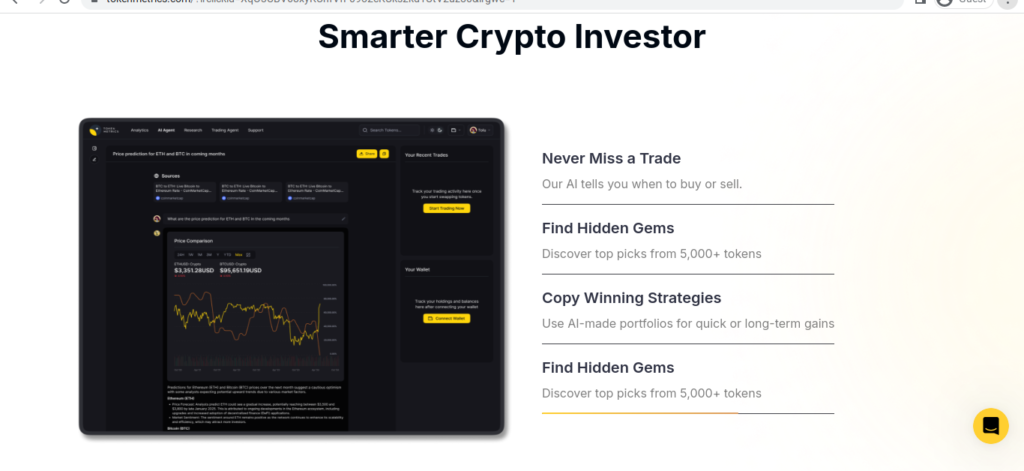Find the best crypto research, price predictions, forecasts, signals, and NFT analysis at Token Metrics. We use AI and Machine learning to help investors
What is the best [Token Metrics]?
Token Metrics
Here are some categories you can use to compare token metrics platforms for your blog post, aiming for a comprehensive and helpful resource for your readers:

Core Features & Functionality:
- Metrics Tracked: What specific token metrics does each platform track (e.g., price, market cap, trading volume, circulating supply, token distribution, on-chain activity, etc.)? Consider both basic and more advanced metrics.
- Data Accuracy and Reliability: How reliable and up-to-date is the data? What sources do they use? Do they have any error checking or data validation processes?
- Analytics and Visualization: What kind of analytical tools are offered? Can users create custom dashboards, charts, and reports? Are there any predictive analytics features?
- Alerting and Notifications: Can users set up alerts for specific metric changes or events? What notification methods are available (e.g., email, SMS)?
- Portfolio Tracking: Can users track their own token portfolios within the platform? How detailed is the portfolio tracking functionality?
User Experience & Accessibility:
- Ease of Use: How intuitive and user-friendly is the platform’s interface? Is it easy to navigate and find the information you need?
- Mobile Accessibility: Is there a mobile app or a mobile-friendly version of the website?
- Integrations: Does the platform integrate with other tools or platforms (e.g., trading exchanges, wallets, data APIs)?

Pricing & Support:
- Pricing Plans: What are the different pricing tiers and what features are included in each? Is there a free trial or a free version available?
- Customer Support: What kind of customer support is offered (e.g., documentation, FAQs, email, live chat)? How responsive and helpful is the support team?
Other Considerations:
- Data Export: Can users export data in various formats (e.g., CSV, Excel)?
- Security: How secure is the platform? What measures are in place to protect user data?
- Community and Resources: Is there an active community forum or blog where users can discuss token metrics and get help?
- Reputation and Reviews: What is the platform’s reputation in the crypto community? What are users saying about it in reviews and forums?
- Specific Token Support: Does the platform support all tokens, or only a select few? If the latter, which chains or tokens are covered? (This is especially important for niche tokens).

Decoding Token Metrics: A Guide to Understanding Crypto Value
Understanding token metrics is crucial for anyone navigating the complex world of cryptocurrency. Whether you’re a seasoned investor or just starting your crypto journey, analyzing token metrics can help you make informed decisions and assess the true potential of a project. This guide breaks down the key token metrics you need to know.
Token metrics are quantifiable data points that provide insights into a cryptocurrency’s performance, utility, and overall health. Just like traditional financial metrics are used to evaluate stocks, token metrics offer a framework for analyzing and comparing different cryptocurrencies. By understanding these metrics, you can gain a deeper understanding of a token’s underlying technology, adoption rate, and potential for growth.
Key Token Metrics to Watch:
- Market Capitalization: This is calculated by multiplying the current price of a token by its circulating supply. It gives you a sense of the overall market value of the cryptocurrency. (Image: Example market cap calculation)
- Price: The current trading price of a token. While important, price alone doesn’t tell the whole story.
- Circulating Supply: The number of tokens that are currently in circulation and available for trading.
- Total Supply: The total number of tokens that will ever exist. Understanding the difference between circulating and total supply is crucial for assessing potential inflation. (Image: Example of circulating vs. total supply graph)
- Trading Volume: The total value of tokens traded over a specific period (usually 24 hours). High trading volume can indicate strong interest and liquidity.
- 24h Change: The percentage change in price over the past 24 hours.
- On-Chain Activity: This refers to transactions and other activity happening on the blockchain itself. Metrics like transaction count, transaction value, and active addresses can provide insights into the network’s usage and adoption. (Image: Example of a blockchain explorer showing on-chain activity)
- Token Distribution: How the tokens are distributed among different holders (e.g., founders, investors, community). A highly centralized distribution can be a red flag.
- Utility: What is the token’s purpose? Does it have a real-world use case within a specific ecosystem or platform? A strong utility is often a key driver of long-term value.
- Community & Social Sentiment: While not strictly quantitative, the size and engagement of a project’s community can be an important indicator of its potential. Social media sentiment can also provide insights, though it should be taken with a grain of salt. (Image: Example of a social media sentiment analysis graph)
- Developer Activity: How actively is the project’s development team working on improvements and updates? This can be gauged by looking at code commits, bug fixes, and new feature releases.
Why are Token Metrics Important?
Analyzing token metrics allows you to:
- Compare different cryptocurrencies: Metrics provide a standardized way to evaluate and compare various projects.
- Identify undervalued or overvalued assets: By looking at metrics like market cap, price, and utility, you can get a sense of whether a token is potentially undervalued or overvalued.
- Assess the long-term potential of a project: Metrics like on-chain activity, token distribution, and developer activity can give you insights into a project’s long-term viability.
- Make informed investment decisions: By combining fundamental analysis with technical analysis (looking at price charts), you can make more informed investment decisions.
Several platforms provide token metrics data, including:
- CoinMarketCap
- CoinGecko
- Messari
- Glassnode
Conclusion:
Understanding token metrics is essential for anyone looking to invest in or participate in the cryptocurrency market. By carefully analyzing these metrics, you can gain a deeper understanding of a project’s potential and make more informed decisions. Remember that no single metric tells the whole story, and it’s important to consider a variety of factors before making any investment decisions.


